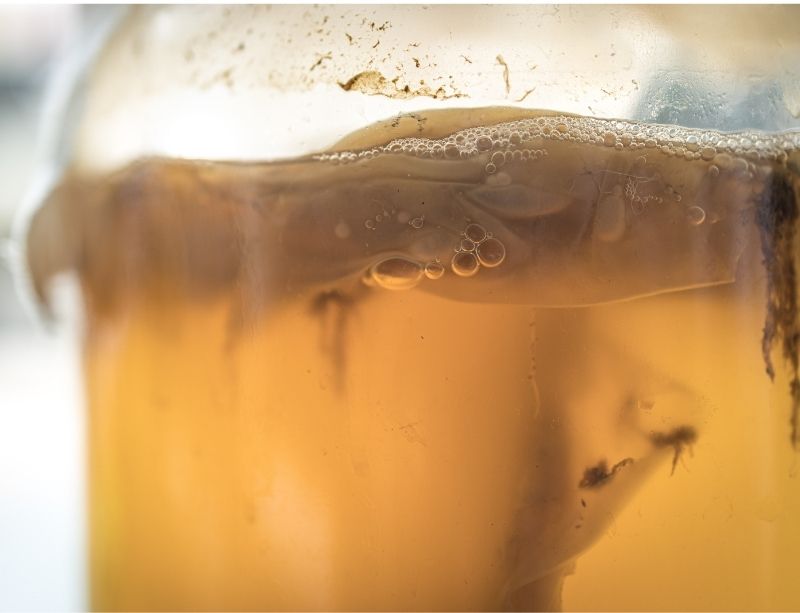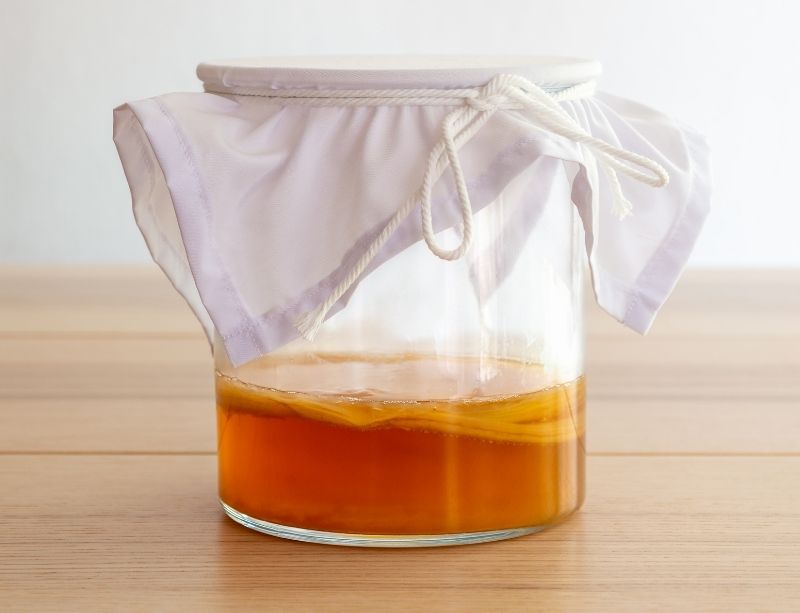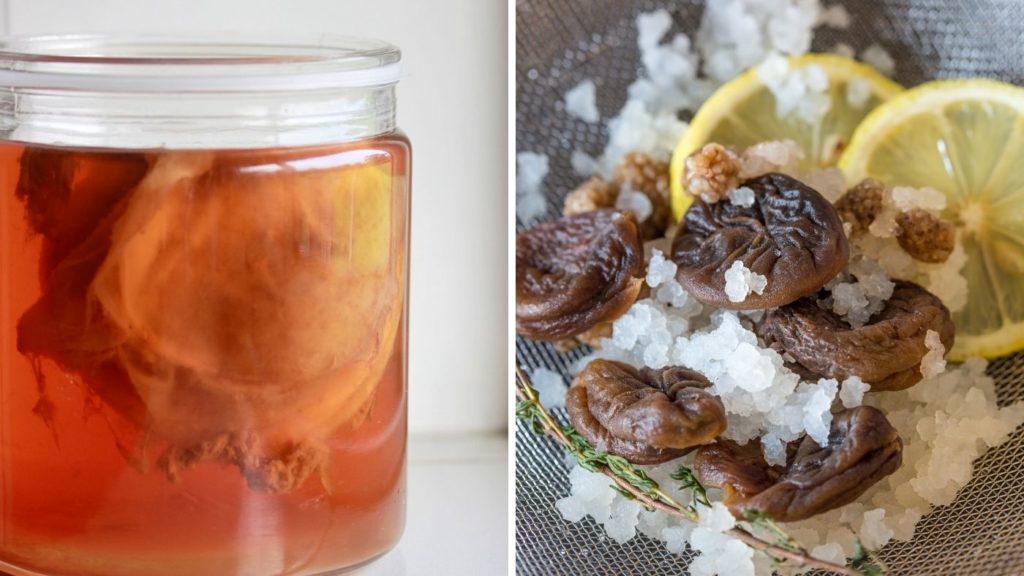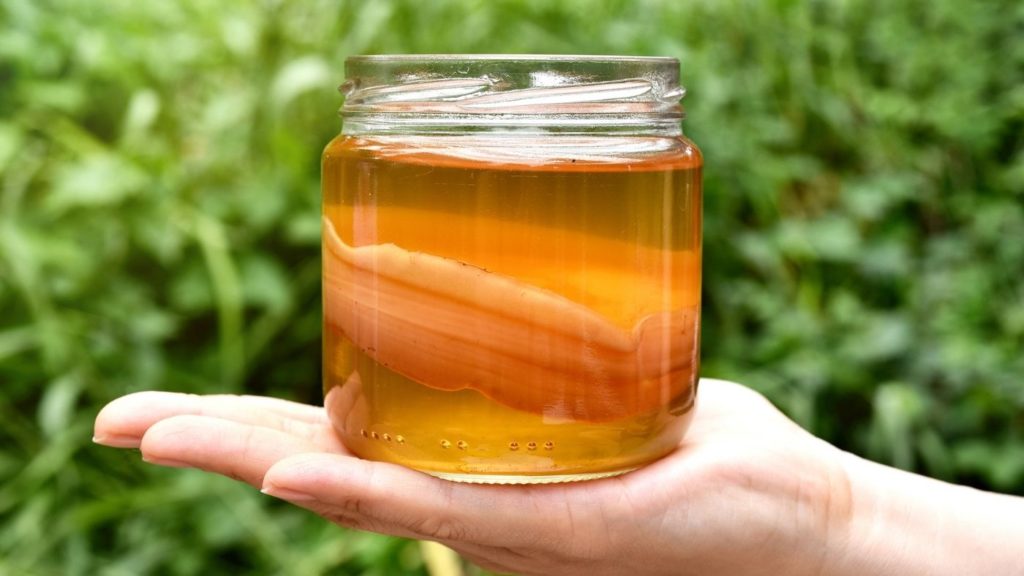Are you just starting to ferment homemade kombucha, and you’re not sure how to store your kombucha scoby between batches? Here’s how!
A kombucha scoby is a starter culture that enables you to start fermenting kombucha.
The beauty of it is that it can be reused endlessly! Once you’ve finished fermenting your kombucha, simply recuperate the scoby and store it to start a new kombucha recipe.
The easiest way to store a kombucha scoby is to start a new fermentation just after bottling. However, you can space out two fermentations if you keep the scoby at room temperature or in the fridge.
Our storage advice also applies to jun scoby, as these are similar cultures.
Go straight to the section that interests you:
- How much scoby to store?
- Keeping refrigerated
- Storing at room temperature
- How do you know if the scoby is still alive?
What Is a Scoby?
A kombucha scoby is a healthy, freshly harvested kombucha in which there is a gelatinous film swimming around. The liquid is essential to start fermentation, while the film is optional, as it lacks sufficient microorganism content.
So, it’s important to understand that there’s more to a ‘kombucha scoby’ than just the gelatinous film! The latter, mainly made of cellulose, cannot start kombucha fermentation on its own.
Kombucha fermentation starts with fresh, healthy kombucha (called liquid culture)! Film is optional but usually included (as long as it’s not too voluminous).
To find out more, read What Is a Kombucha Scoby? and Is a Kombucha Scoby a Mushroom?
How Much Kombucha Scoby Should I Keep?
To make a 3-litre kombucha recipe, we recommend saving about 500 ml (2 cups) of starter culture (plain liquid kombucha).
The amount of scoby to keep depends on the volume of the next recipe; it is essential to add enough to ensure the fermentation process starts correctly.
The general rule is to keep at least 10% of the volume of your next recipe.
La règle générale est de conserver minimum 10% du volume de votre prochaine recette.
Examples:
- To make 3L of kombucha, keep 300 ml of starter culture.
- To make 15L of kombucha, keep 1.5 L of starter culture.
You could put in more (as we do with our kombucha scobys made from organic ingredients!), but less is not recommended in order to avoid mould.

The quality of the kombucha used is important, as it guarantees the quality of the fermentation and therefore the kombucha produced.
You can keep the film, but make sure there’s always more liquid than film.
Storing Your Kombucha Scoby in the Fridge
The easiest way to store kombucha is in a sealed container in the fridge.
Always indicate what’s in the jar so that no one in your household gets rid of it by mistake!
The scoby will then go dormant and can be kept for up to 6 months.
However, we’ve already seen scobys that had been forgotten for over a year in a corner of the fridge come back to life without any problem. These little creatures are resilient!
Storing Your Kombucha Scoby at Room Temperature
You can store your kombucha scoby at room temperature in a jar covered with a cloth. However, you’ll need to feed it regularly.
This is a slightly more laborious method of storage than refrigeration, but it makes the culture more active faster.
At room temperature, the microorganisms in the kombucha are not dormant as they are in the fridge, so the scoby will continue to acidify. Therefore, you’ll need to add sweet tea from time to time.
Remember to feed it well, otherwise, it will end up as kombucha vinegar!

Steps to follow to store a kombucha scoby at room temperature:
- Place the kombucha and, if you like, the film, in a jar (about 10% of the volume of your next recipe).
- Bring 250 ml (1 cup) of water to the boil.
- Brew 1 sachet (2 g) of tea for 30 minutes.
- Add 50 g (¼ cup) sugar.
- Stir to dissolve the sugar.
- Once lukewarm, add the sweetened tea to the kombucha scoby.
- Cover with a cloth with a rubber band.
- Repeat adding lukewarm sweet tea every fortnight.
If you store your scoby this way for several months, new films will form on the surface. Compost, cook, give away, or throw away the old ones and keep only the top one. It is the youngest and the one that contains the most active microorganisms.
To preserve a jun scoby at room temperature, follow the same steps, replacing the sugar with honey.
Scoby Hotel: Bad Idea!
A kombucha hotel (or scoby hotel) is several films of kombucha piled up in a jar filled with kombucha.
A kombucha hotel is aesthetically very interesting, but it doesn’t give you a good culture to start with. We therefore advise against using this technique to store kombucha scobys.
The most important thing is to have a living liquid kombucha. A scoby hotel leaves almost no room for the liquid.
What’s more, the kombucha scobys at the bottom of the jar won’t have access to the oxygen above. Yeast will disappear and the culture will lose its vitality.
Is My Kombucha Scoby Still Alive?
It is impossible to tell whether a kombucha scoby is still active by her appearance, colour, or smell. The only exception is if there’s mould on the surface, throw it all away.
The only way to know if a kombucha scoby is alive and well is to ferment it again. If there are enough active microorganisms, the sweet tea will acidify, the sugar will gradually disappear and a new kombucha scoby will slowly develop on the surface.
If you have any doubts about the vitality of your scoby, don’t hesitate to use more starter culture than usual.
If, after 3 weeks of fermentation at room temperature, the kombucha is still quite sweet, not very acidic, or no scoby is present on the surface, then you can conclude that your kombucha scoby is probably dead.
To find out more, see Is My Kombucha Scoby Sick?

